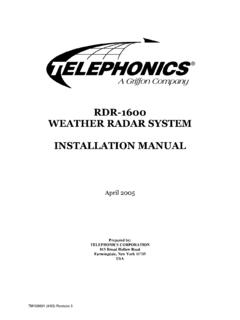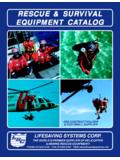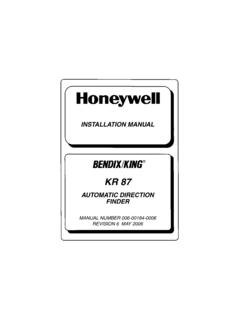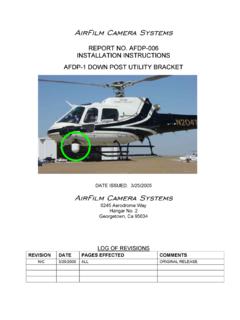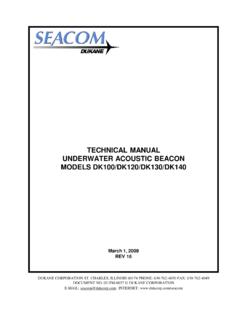Transcription of Pilot’s Guide RDR-1600 Color Weather and Search …
1 Pilot's Guide RDR- 1600 . Color Weather and Search and Rescue Radar Command Systems Division TM106101 October 2004. TABLE OF CONTENTS. PARAGRAPH TITLE PAGE. INTRODUCTION ..1. ADVISORY CIRCULAR ..2. SAFETY ADVISORY ..11. WARNING ..13. CAUTION ..13. MAXIMUM PERMISSIBLE. EXPOSURE LEVEL (MPEL) ..14. SYSTEM CONFIGURATION ..15. ANTENNA AND RECEIVER-TRANSMITTER ..16. RADAR DISPLAY INDICATOR ..17. OPERATIONAL CONTROLS ..18. FUNCTION SELECTOR CP-113K. CONTROL PANEL ..18. ANTENNA CONTROLS ..19. DISPLAY CONTROLS ..19. PRIMARY MODE SELECTORS.
2 19. SECONDARY MODE SELECTOR AND GAIN. CONTROLS ..21. ALPHANUMERICS ..22. PREFLIGHT (PFT) ..23. PREFLIGHT WARNING ..23. THEORY OF OPERATION ..24. GENERAL ..24. RADAR PRINCIPLES ..25. Weather RADAR PRINCIPLES ..26. RADAR REFLECTIVITY ..27. Weather DISPLAY CALIBRATION ..28. Weather ATTENUATION COMPENSATION ..29. Weather OPERATIONS ..31. Weather MODE WX ..31. Weather ALERT MODE WXA ..32. TARGET ALERT ..32. Weather MAPPING AND INTERPRETATION ..33. OBSERVING Weather ..33. Thunderstorms and Turbulence ..34. Tornadoes ..35. Hail ..36. Icing.
3 37. Snow ..37. Lightning and Static Discharges ..37. TM106101 (10/04) RDR- 1600 Pilot's Guide i TABLE OF CONTENTS (CONT.). PARAGRAPH TITLE PAGE. Range Resolution ..38. Azimuth Resolution ..38. Indicator Resolution ..39. Short Range Displays ..40. PATH PLANNING ..41. Path Planning Considerations ..41. Search OPERATIONS ..44. GROUND MAPPING ..44. Looking Angle ..45. Other Aircraft ..46. Search MODE ..46. DIFFERENCE BETWEEN Weather AND. Search MODES ..47. Search MODES COMPARED ..48. Search 3 ..48. Search 2 ..49. Search 1 ..49. TILT MANAGEMENT.
4 50. TILT CONTROL ..50. TILT PERFORMANCE CHECK ..51. EARLY DETECTION OF ENROUTE Weather ..52. ANTENNA STABILIZATION ..53. LIMITS ..53. ERRORS ..53. COMPENSATION ..54. BEACON MODES ..55. BEACON FORMAT SELECTION ..56. DO-172 ..56. AC 90-80 ..57. MULTIPLE INDICATORS ..58. SYSTEM SPECIFICATIONS ..59. RT-1601 RT UNIT ..59. DA-1203A ANTENNA DRIVE ASSEMBLY ..59. CP-113K CONTROL PANEL ..60. ii RDR- 1600 Pilot's Guide TM106101 (10/04). LIST OF ILLUSTRATIONS. FIGURE TITLE PAGE. Cross-Section of a Thunderstorm .. 4. 2-1 Typical System Block Diagram.
5 15. Receiver-Transmitter ..16. DA-1203A Drive Assembly with AA4512A 12 . Flat Plate Antenna ..16. CP-113K Control Panel ..16. MFD Display ..17. CP-113K Control Panel ..18. Tilt Control ..19. Primary Mode Selectors ..20. Secondary Mode Selector and Gain Controls ..21. MFD Screen Presentations ..22. Preflight Warnings ..23. Radar Transmit-Receive Timing ..25. Reflective Levels ..27. STC Electronically Compensates for Distance Attenuation ..29. Typical Weather Display ..31. Weather Alert with Target Alert Display ..32. Storm Components.
6 33. Finger ..36. Hook ..36. Scalloped Edge ..36. U-Shaped ..36. Azimuth Resolution ..38. Short Range Display ..40. Penetration of Weather ..41. Minimizing Doglegging ..42. Blind Alley or Box Canyon Situations ..42. Over Terrain ..44. Over Water ..44. A Smaller Incident Angle ..45. Concentration of the Beam ..45. Wx and SRCH Buttons ..47. Search 3 ..48. Search 2 ..49. Search 1 ..49. TM106101 (10/04) RDR- 1600 Pilot's Guide iii LIST OF ILLUSTRATIONS (CONT.). FIGURE TITLE PAGE. Adjusting the Antenna Tilt ..50. Altitude vs. Range ..51.
7 Weather Target ..52. Aircraft Pitching/Rolling 30 ..53. Standard Beacon ..56. DO-172 ..56. LIST OF TABLES. TABLE TITLE PAGE. Radar Display and Thunderstorm Levels versus Rainfall Rates ..28. Minimum Distinguishable Target Separation ..39. Antenna Tilt Control Settings ..52. iv RDR- 1600 Pilot's Guide TM106101 (10/04). Introduction INTRODUCTION. In the early days of aviation, pilots were more concerned with just staying airborne than worrying about Weather . Airplanes were for fun. pilots flew only short hops, on clear days, and could often see their destination.
8 There was little need for navigation equipment. If your compass was working and your gas held out, you could probably make it home safely. Later, as flying came of age, thunderstorms and their associated turbulence were more of a problem. When the Weather was good, aircraft utilization was high. But when storms were prevalent, you might take the long way home. Today, Weather radar is as much at home in the cockpit as the compass. Corporate aircraft operators, and private pilots , as well as the airlines have adopted Weather radar with full confidence in its usefulness and reliability.
9 Most commercial airborne Weather radars available today also provide the pilot with one or more ancillary modes of operation and system options that make the radar more functional and increase its versatility. Telephonics would like to welcome you to the growing family of Telephonics Weather Radar System owners and operators. The RDR- 1600 Color Weather Radar System is the newest advancement of this series of radars. The RDR- 1600 series radars are the most popular, advanced capability, multi-mode radars available from any manufacturer.
10 The RDR- 1600 provides five primary modes of operation: three air-to- surface Search and detection modes, and two conventional Weather avoid- ance modes. This lightweight digital X-band radar system provides a peak power of 10 kW, and is primarily designed for fixed or rotary-wing aircraft engaged in patrol, Search and rescue missions, and for transporting personnel and equipment to remote sites ( , off-shore oil rigs, etc.). The system interfaces with multi-function electronic displays. The MFD is referred to as an indicator in this manual.
